When most people think of Andalusia, they picture Seville’s flamenco passion or Granada’s majestic Alhambra. But tucked between these two stars lies Córdoba—a city that honestly stole my heart in ways I didn’t expect. Walking through its narrow whitewashed streets felt like stepping into a living museum where Islamic, Jewish, and Christian histories blend seamlessly. I’m writing this guide because Córdoba deserves more than a rushed day trip. It deserves your full attention.
What to do in Córdoba Spain goes far beyond checking off a famous mosque-cathedral from your list. This city rewards curious wanderers who peek into hidden alleyways, linger over cold bowls of salmorejo, and lose themselves in the scent of jasmine drifting from ancient patios. Over my three days here, I discovered why locals call this place special—and I’m excited to share everything with you.
Quick tip from my experience: Visit Córdoba in spring (especially May during the Patio Festival) or autumn when temperatures are comfortable for walking. The summer heat can be brutal—I’m talking 40°C+ days. Plan to stay at least 2-3 days to truly soak in the atmosphere without rushing.

Quick Reference Table
| Essential Info | Details |
| Best Time to Visit | May (Patio Festival), April, October, November |
| Ideal Duration | 2-3 days (minimum 1 full day) |
| Getting Around | Walking (most attractions within 1-2 km) |
| Must-Try Food | Salmorejo, ajoblanco, berenjenas con miel |
| Top Attraction | Mezquita-Cathedral de Córdoba |
| Day Trip Options | Seville (45 min), Granada (2.5 hrs), Málaga (1 hr) |
| Currency | Euro (€) |
| Language | Spanish (English spoken in tourist areas) |
Wondering What to Do in Córdoba? These are Must-See Icons of Córdoba
1. Mezquita-Cathedral de Córdoba: Where Two Faiths Become One
The first time I walked into the Mezquita, I literally stopped in my tracks. Imagine 856 columns creating a forest of red-and-white striped arches that seem to stretch infinitely in every direction. This is the crown jewel of Córdoba Spain attractions, and it’s unlike anything else in Europe.
Here’s what makes it extraordinary: in the 8th century, this was one of the world’s largest mosques, built during the Islamic rule of Al-Andalus. The Moorish architecture is breathtaking—intricate geometric patterns, horseshoe arches, and a mihrab (prayer niche) covered in gold mosaics that shimmer even in dim light. Then, after the Christian reconquest in the 13th century, they built a Renaissance cathedral right in the middle of the mosque. Controversial? Absolutely. Visually stunning? Undeniably.
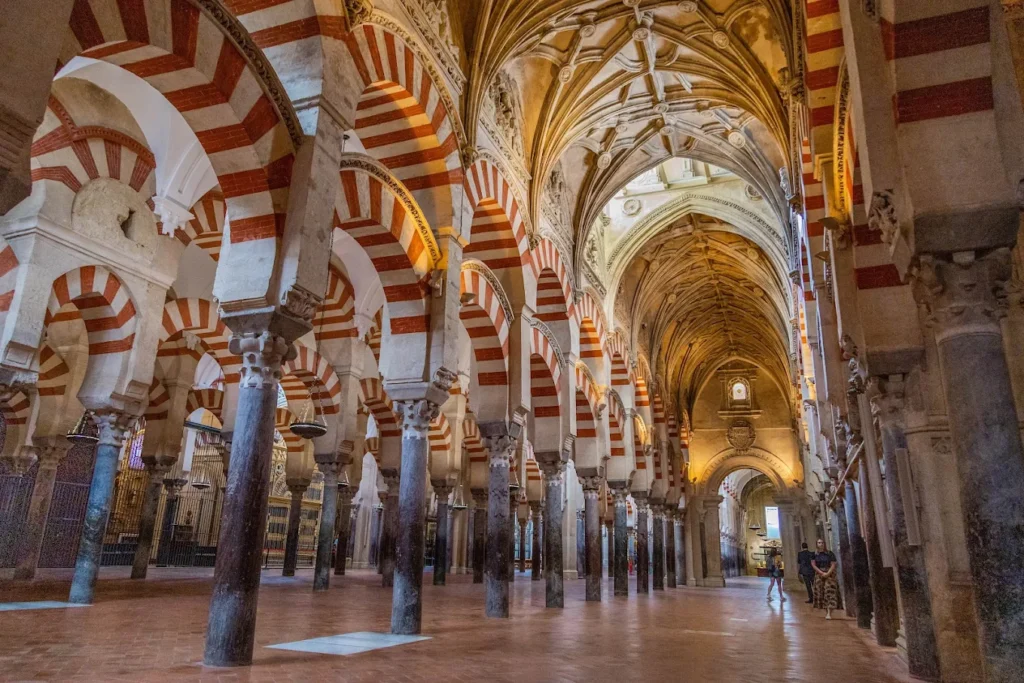
My insider tips:
- Visit between 4:00-5:30 PM when afternoon light streams through the cathedral windows, creating magical shadows through the columns
- Better yet, book the night visit (€18) when the mosque is illuminated and crowds have vanished—it’s almost spiritual
- Skip the morning rush between 10:00 AM-12:00 PM when tour groups flood in
- Entry costs around €13 (check the official Mezquita website for current prices and to book tickets online)
- Dress modestly (covered shoulders and knees)—they’re strict about this
Accessibility note: The main prayer hall is wheelchair accessible via ramps, but the bell tower climb involves narrow spiral stairs.
2. Roman Bridge & Torre de Calahorra: Sunset Magic
After visiting the Mezquita, I walked straight to the Puente Romano (Roman Bridge) for sunset, and wow—it’s the perfect way to end your afternoon. This 16-arch bridge dates back to the 1st century BC, though it’s been restored many times over 2,000 years.
The walk across offers postcard views of the Mezquita reflecting in the Guadalquivir River, with the old city walls forming a golden backdrop. At the far end stands the Torre de Calahorra, a defensive tower that now houses a small museum about the city’s multicultural history.
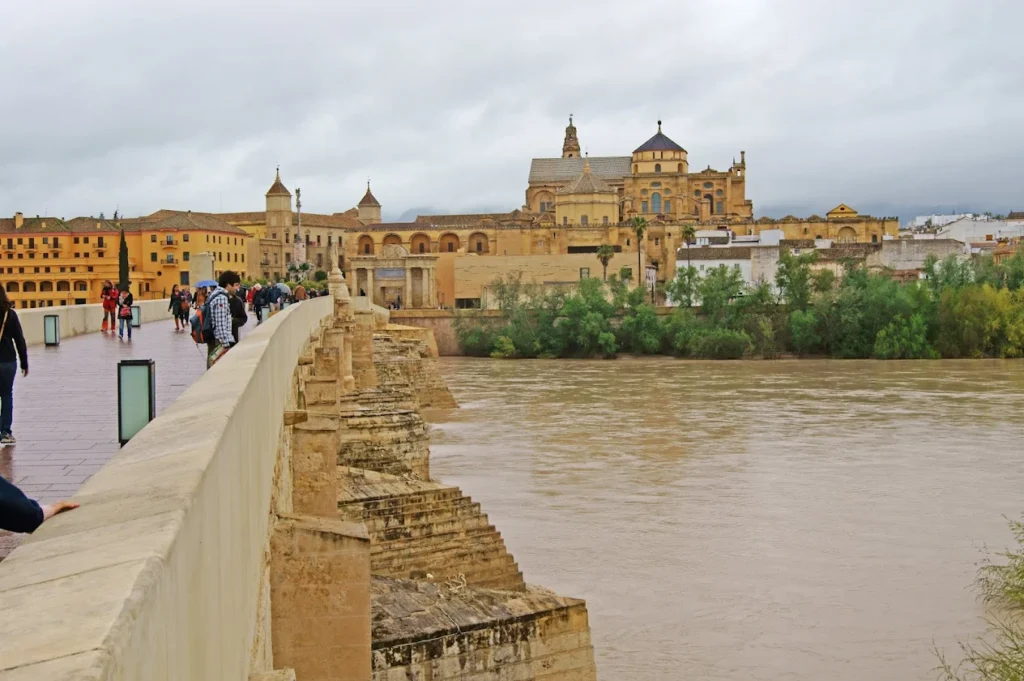
My recommendations:
- Come at golden hour (about an hour before sunset) for the best photos
- The bridge itself is free to walk across anytime
- The tower museum is interesting but skippable if you’re short on time—save your energy for more unique experiences
- Look for the statue of Archangel Raphael in the middle of the bridge, Córdoba’s patron saint
3. Alcázar de los Reyes Cristianos + Gardens: An Evening Oasis
The Alcázar (fortress-palace) was home to Christian monarchs, including Ferdinand and Isabella who met Christopher Columbus here. But honestly? I came for the gardens, and they exceeded all expectations.
Geometric hedges, fountains, pools, and orange trees create a serene escape from the bustling old town. I spent over an hour just sitting by the water features, watching goldfish swim and feeling the cool breeze.
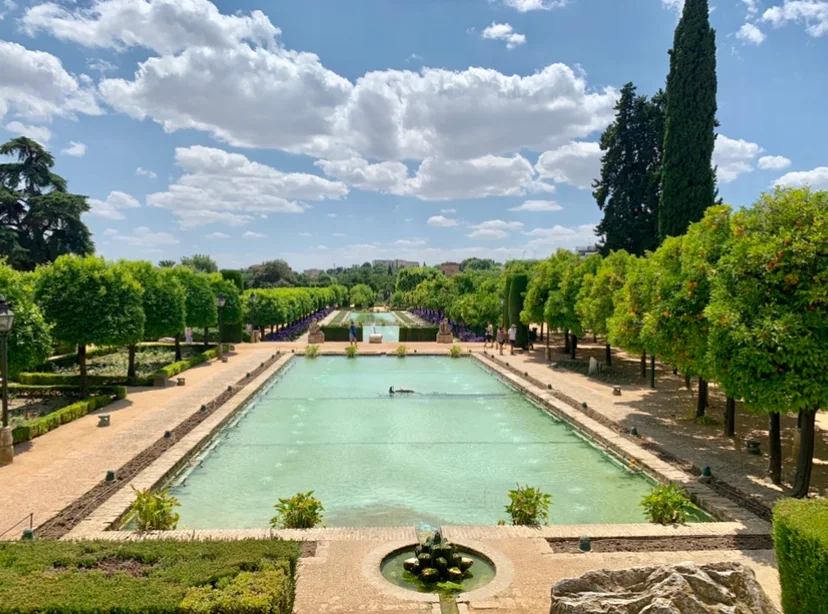
Don’t miss:
- The “Magical Nights” experience (Noches Mágicas) if you visit between July-September—the gardens are illuminated with colored lights and projection mapping. Check the official Alcázar website for schedules and tickets
- Tower views over the city and gardens (there are four towers you can climb)
- The Roman mosaics inside, though they’re less impressive than the outdoor spaces
- Entry is about €5 and includes gardens + interior
Local tip: Tuesdays after 2:00 PM are free for EU citizens. Even if you’re not eligible, it’ll be more crowded then.
4. Palacio de Viana & Its Patios: A Journey Through 12 Gardens
Córdoba is famous for its Andalusian patios—interior courtyards filled with flowers, tiles, and fountains. The Palacio de Viana takes this concept to another level with 12 distinct patios, each with its own personality.
I found myself fascinated by how each patio represented different eras and styles. Some are minimalist with just white walls and geraniums. Others explode with color—hundreds of flower pots climbing the walls, ceramic tiles telling stories, and water features creating soothing sounds.
The palace interior showcases aristocratic life with period furniture, art, and a fascinating leather collection (Córdoba was historically famous for leatherwork).
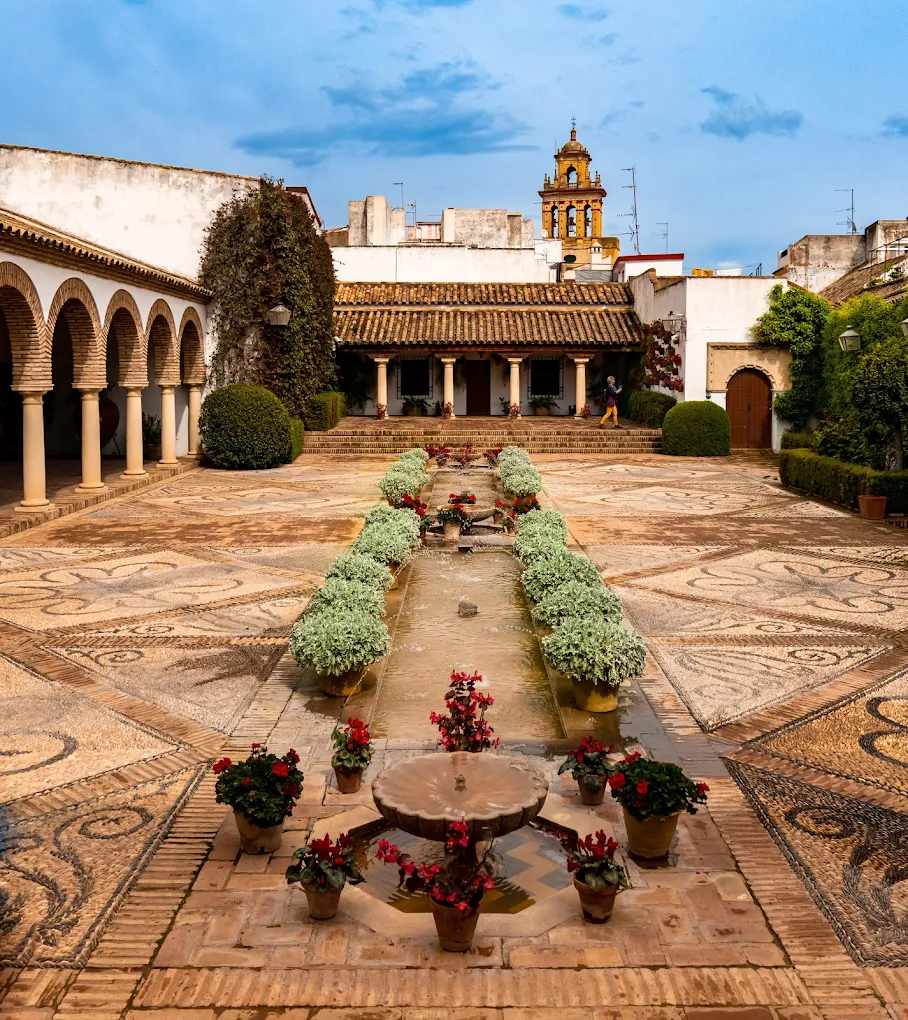
Practical info:
- Entry costs about €10 for patios + palace, or €7 for just the patios
- Open Tuesday-Sunday (closed Mondays and certain holidays)
- Takes about 1-1.5 hours to explore properly
- Visit in the morning when flowers are freshest and it’s less crowded
Historic Quarters & Hidden Streets
5. Jewish Quarter (La Judería): Getting Lost is the Goal
The Jewish Quarter is where Córdoba’s magic really happens. These narrow, whitewashed streets twist and turn unpredictably, with flower pots cascading from balconies and sudden glimpses of ornate doorways. I gave up trying to follow my map and just wandered—which turned out to be the best decision.
The Jewish heritage Córdoba is significant. This was one of Spain’s most important Jewish communities in medieval times, producing philosophers like Maimonides (you’ll see his statue in the square). The Synagogue, built in 1315, is one of only three medieval synagogues remaining in Spain. It’s small but beautifully preserved with Mudéjar plasterwork and Hebrew inscriptions.
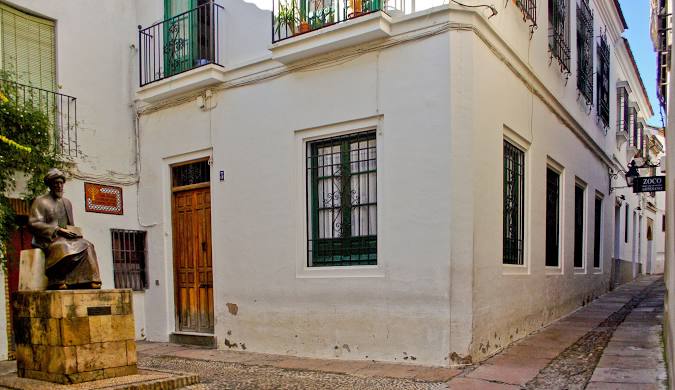
My suggested walking route:
- Start at Plaza de Maimónides (photo with the Maimonides statue)
- Visit the Synagogue (€0.30 entry, free for EU citizens)
- Wander through Calle Judíos spotting artisan shops
- Duck into side streets—seriously, just pick random lanes
- End at Calleja de las Flores (see below)
Shopping note: This area has many souvenir shops selling leather goods, ceramics, and jewelry. Quality varies—look for shops that clearly make items locally.
6. Puerta Almodóvar & City Walls: Gateway to the Past
The Puerta Almodóvar is the most impressive of the old city gates, with its crenellated towers flanking a horseshoe arch. It marks the entrance to the historic bridges Spain area and the Jewish Quarter.
The preserved sections of the city walls near here make you realize just how fortified Córdoba once was. I recommend walking along Ronda de Marrubial for views of the walls from outside.
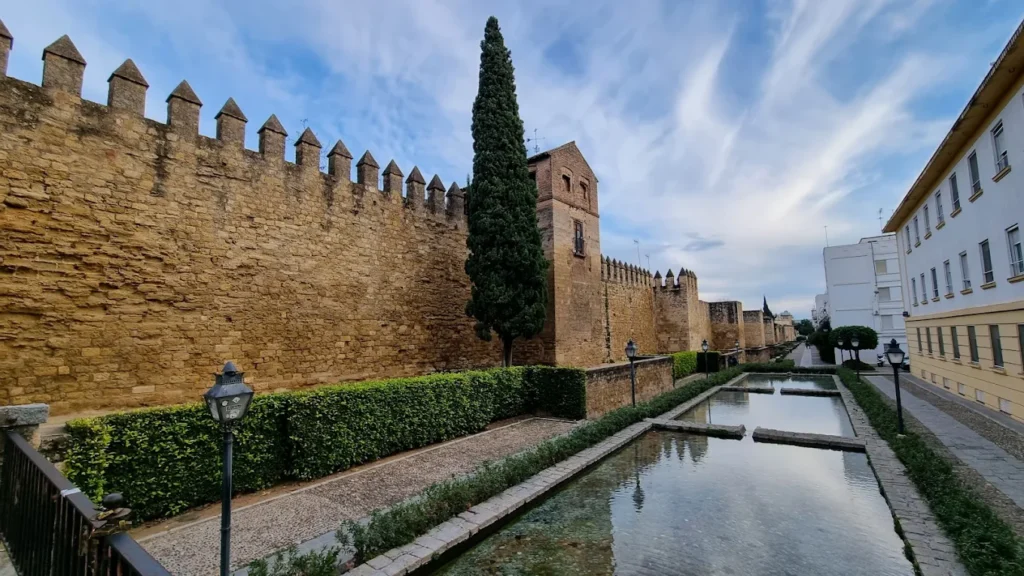
Photo tip: Come early morning (8:00-9:00 AM) for photos without crowds, or at blue hour for dramatic lighting.
7. Calleja de las Flores & Calleja del Salmorejo: Instagram Meets Tradition
Calleja de las Flores (Flower Alley) might be Córdoba’s most photographed spot. This tiny lane is just a few meters long, with potted geraniums lining white walls and a perfect frame of the Mezquita tower at the end.
Yes, it’s touristy. Yes, you’ll wait for other people to finish their photos. But honestly? It’s worth it, especially in May when flowers are in full bloom.
Calleja del Salmorejo is nearby and equally charming. What I loved here is the ceramic tiles on the wall showing the traditional recipe for salmorejo—Córdoba’s famous cold tomato soup. It’s a fun, functional piece of street art that celebrates local gastronomy Córdoba.
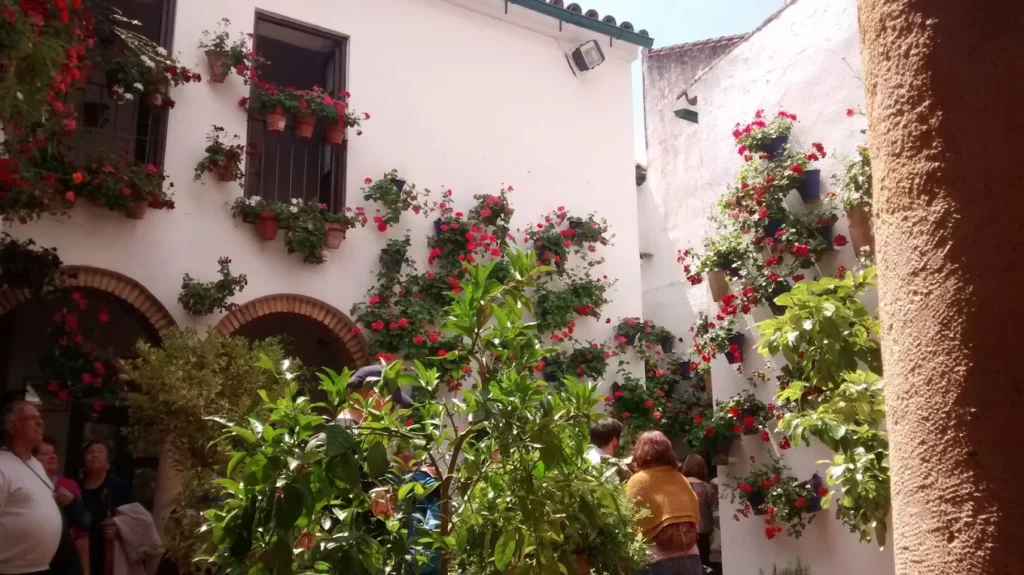
Take the recipe photo and make it at home! I did, and it transported me right back to Córdoba’s summer flavors.
8. Calleja Pañuelo & Narrow Alleys: Micro-Adventures
Calleja del Pañuelo translates to “Handkerchief Alley” because it’s so narrow you could theoretically stretch a handkerchief across it. At its tightest point, it’s barely wide enough for one person with arms outstretched.
These hidden alleyways are all over Córdoba’s old town. I spent an entire afternoon discovering them—some barely make it onto maps. My advice? Embrace getting lost. Download offline maps on your phone, but put it away and just explore. Some of my favorite moments were stumbling onto local neighborhood squares where elderly residents sat chatting, or finding tiny workshops where craftsmen made traditional goods.
Safety note: Córdoba is generally very safe, even in narrow alleyways. Just use common sense—stay aware of your surroundings and avoid empty streets late at night.
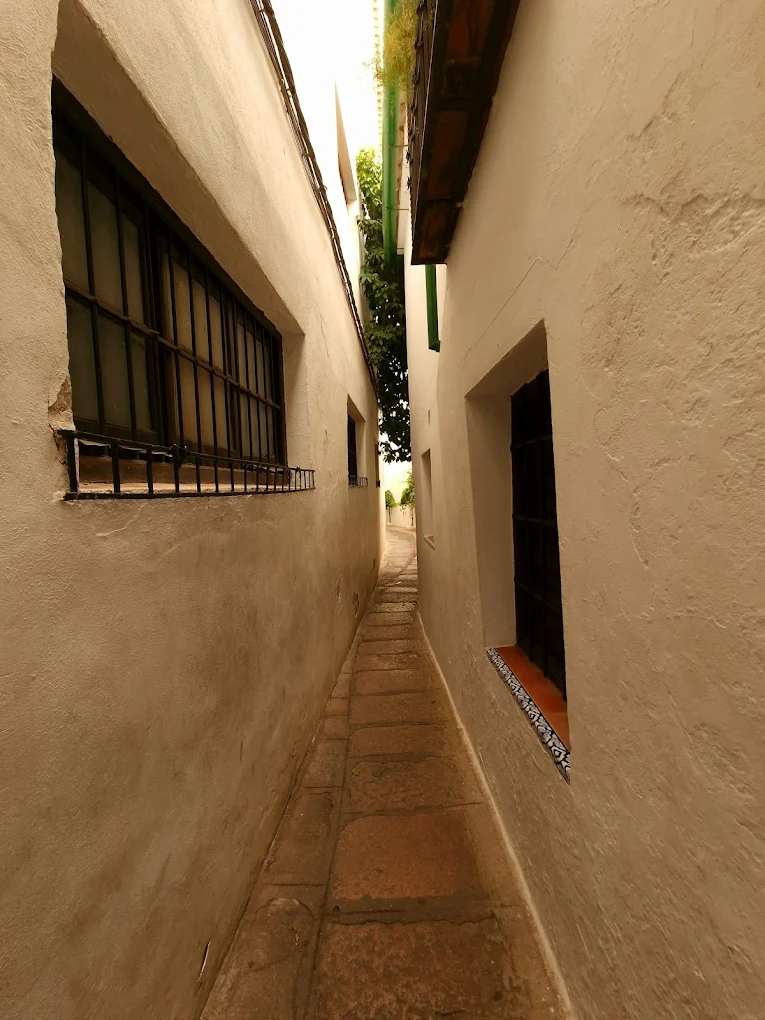
Culture, Museums & Local Life
9. Casa Andalusi & the Alchemy Museum: Step Into Moorish Life
Casa Andalusi is a restored 10th-century Moorish house that shows how people lived during the Caliphate period. The central patio with its fountain, the period furnishings, and the displays of traditional crafts give you context for the architecture you see everywhere.
The small museum of alchemy in the basement is quirky and interesting—it explores medieval Arabic science and the history of papermaking (the Arabs brought papermaking techniques to Spain through Córdoba).
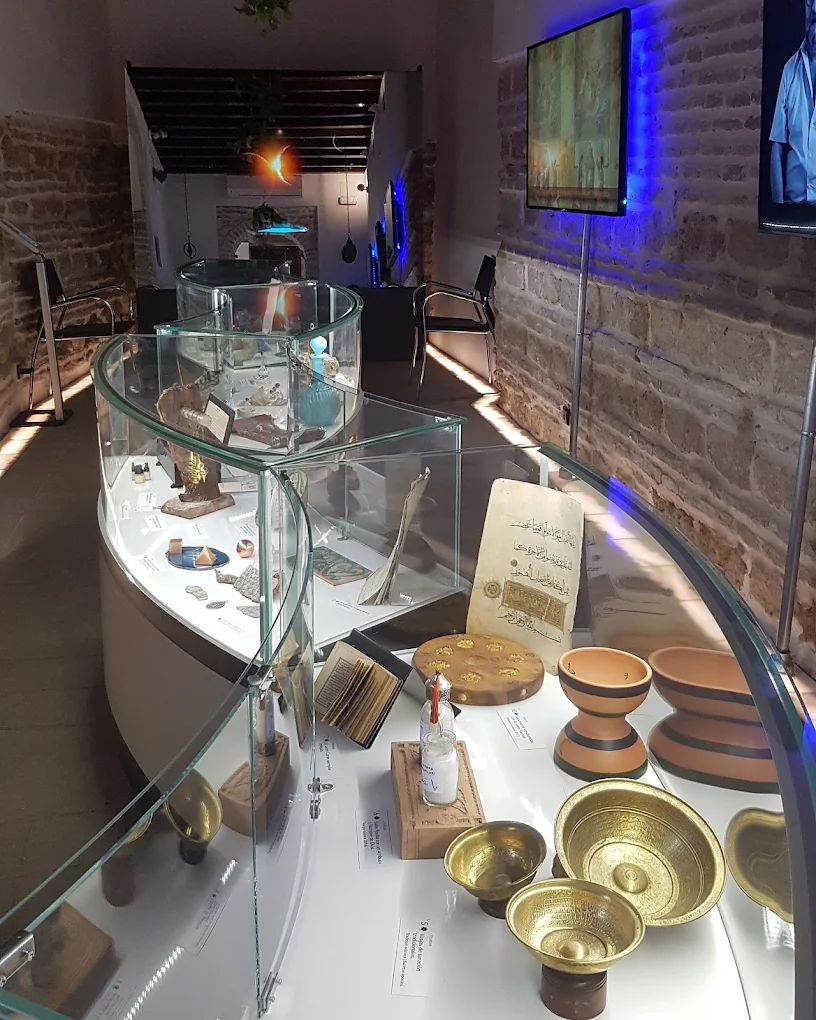
Details:
- Entry around €3
- Takes about 30-45 minutes
- Located in the Jewish Quarter
- Good for history buffs and families
10. Casa de Sefarad (Jewish Heritage Museum): Preserving a Legacy
This museum focuses specifically on the Sephardic Jewish culture that flourished in medieval Córdoba. Through five rooms, you’ll learn about Jewish daily life, traditions, music, and the eventual expulsion of Jews from Spain in 1492.
What touched me most was the section on Judeo-Spanish language (Ladino) and the music room where you can hear traditional Sephardic songs. It adds depth to your walk through the Jewish Quarter.
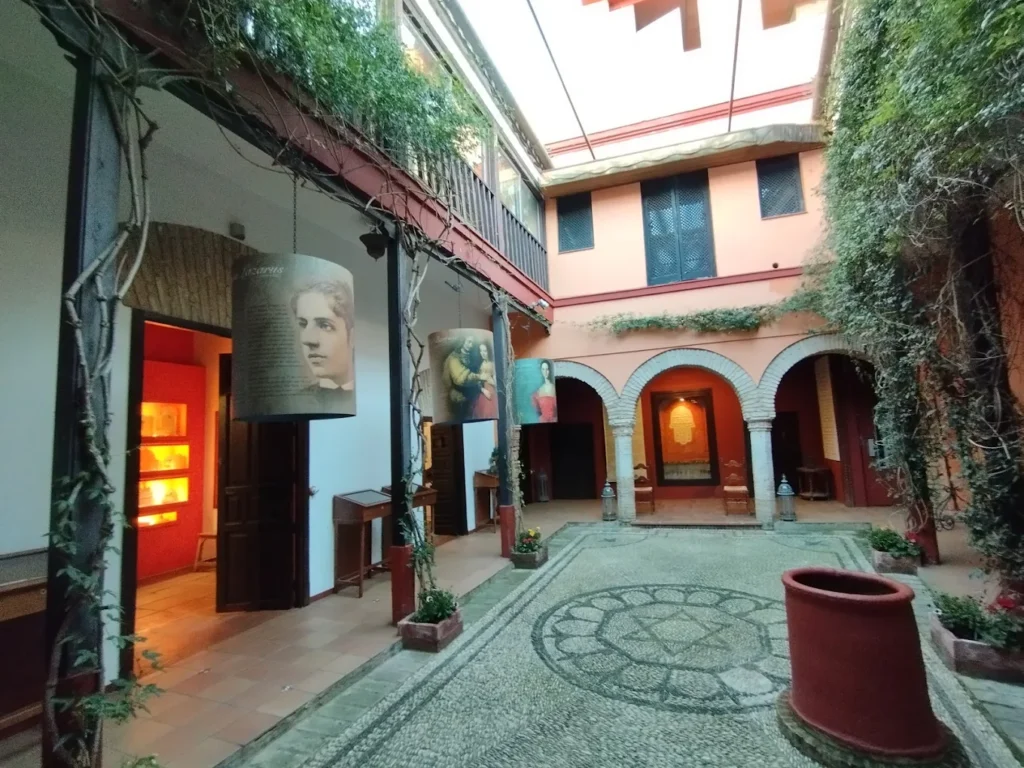
Info:
- Entry about €5
- Includes audio guide
- Small museum, takes 45 minutes
- Often hosts concerts and cultural events
11. Roman Temple Ruins & Archaeological Museum: Ancient Foundations
Most people don’t realize that before it was Islamic or Christian, Córdoba was a major Roman city. The temple ruins on Calle Capitulares are impressive—tall columns rising dramatically from below street level. They’re free to view anytime and beautifully lit at night.
For more context, visit the Archaeological Museum nearby. It houses Roman mosaics, sculptures, and artifacts spanning from prehistory through medieval times. The building itself is a Renaissance palace, which adds to the experience.
Museo Arqueológico details:
- Entry €1.50
- Free for EU citizens
- Closed Mondays
- Allow 1-1.5 hours
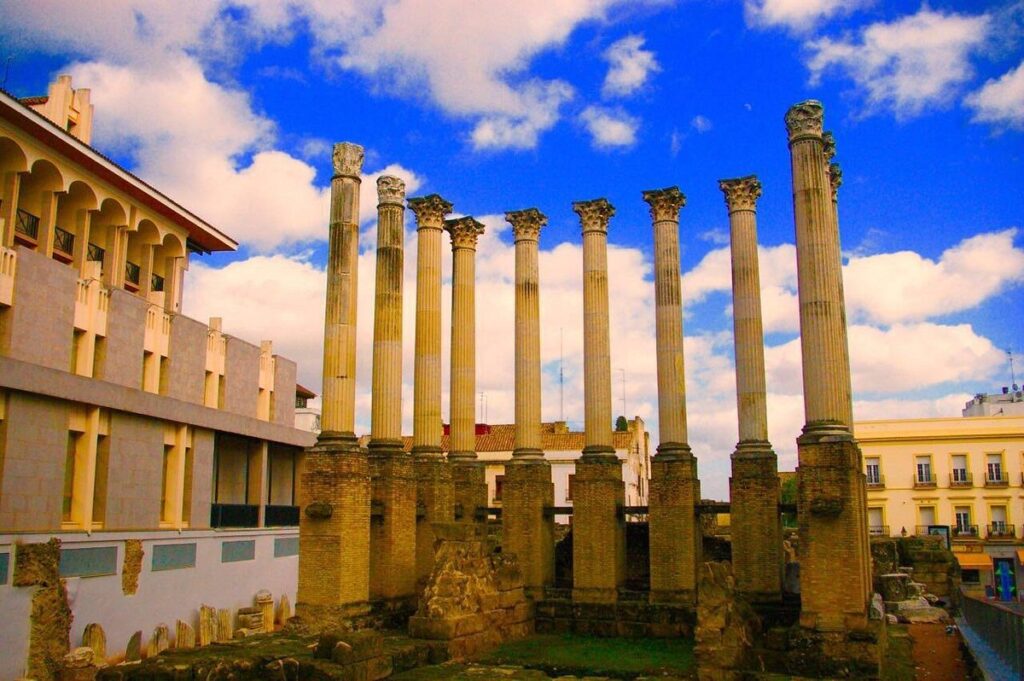
12. Mercado Victoria: Modern Tapas Paradise
When I needed a break from traditional restaurants, Mercado Victoria became my go-to spot. This modern food hall houses about 30 vendors selling everything from traditional tapas to sushi, craft beer to gourmet burgers.
The atmosphere is lively—locals and tourists mix at communal tables, there’s often live music, and you can sample multiple cuisines in one visit. I loved the freedom to try small portions from different vendors without committing to a full sit-down meal.
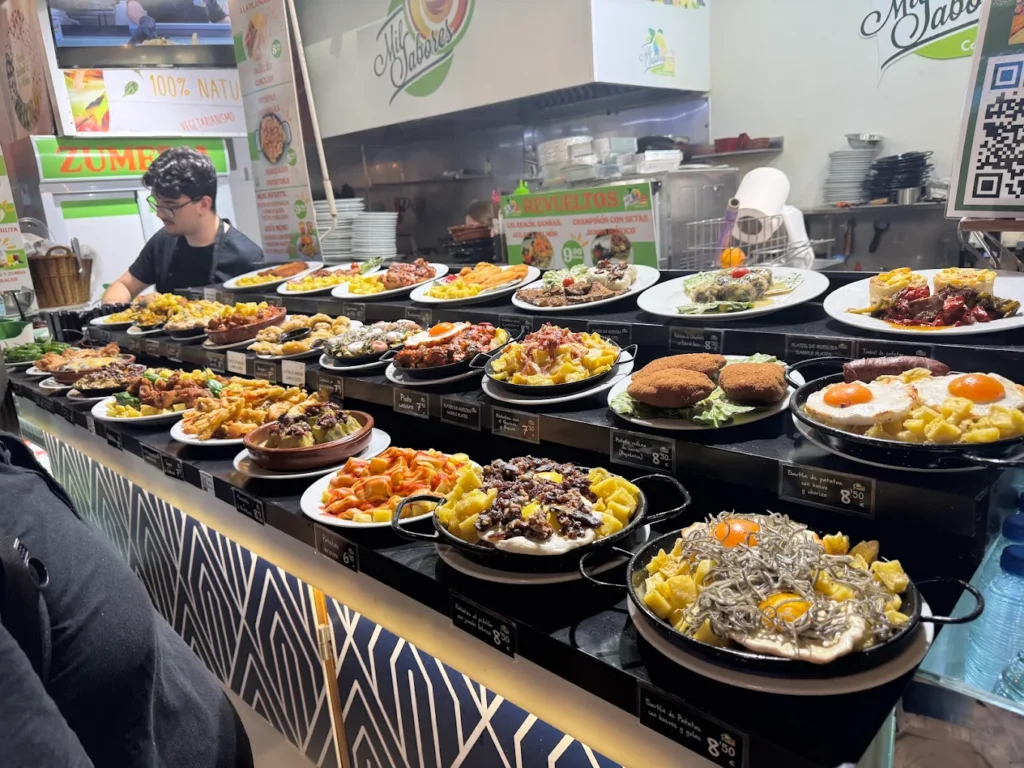
My recommendations:
- Try the artisan vermouth from the vermutería
- Grab empanadas from the Argentine stall
- The craft beer selection is excellent
- Open daily, but busiest Friday-Saturday evenings
- Located outside the old town but worth the 10-minute walk
13. Cafés, Tea Houses & Sweet Spots: Afternoon Breaks
Córdoba’s Arabic heritage shines in its tea houses scattered throughout the Jewish Quarter. These atmospheric spots serve mint tea, Arabic sweets, and hookah (shisha) in low-lit rooms with cushioned seating and Moroccan décor.
For something more traditionally Spanish, I recommend:
- La Bicicleta – hipster café with excellent coffee and homemade cakes
- Pastelería Roldán – local bakery famous for pastel cordobés (a sweet pastry with cidra jam)
- Casa Salinas – historic spot for afternoon coffee and tostadas
Sweet tip: Try tocino de cielo (a flan-like dessert) or alfajores (almond cookies) at any traditional pastry shop.
14. Craft Beer & Local Nightlife: Beyond Wine
While Córdoba isn’t known for wild nightlife, the craft beer scene has grown significantly. CEPA Craftbeer & Wine near the Roman Temple became my evening spot. They offer Spanish craft beers on tap and a carefully curated selection of natural wines.
The vibe is relaxed—locals chatting after work, some tapas to accompany drinks, and bartenders who genuinely love explaining their selection.
Nightlife note: Córdoba is much quieter than Seville or Granada. Most action happens around Plaza de las Tendillas and the streets radiating from it. Things start late (11 PM+) on weekends.
Food, Cooking & Local Flavors
15. Signature Dishes of Córdoba: What You Must Taste
Spanish cold soups are Córdoba’s culinary calling card, especially during scorching summers:
Salmorejo – This thick, creamy tomato soup is richer than gazpacho, made with tomatoes, bread, garlic, olive oil, and salt, topped with hard-boiled egg and jamón. Every restaurant serves it, but I found the best version at Taberna Salinas (a traditional spot locals love).
Ajoblanco – A white version made from almonds, garlic, bread, and olive oil, sometimes served with grapes. It’s refreshing and luxurious, though less common than salmorejo.
Berenjenas con miel (fried eggplant with honey) – Possibly my favorite tapa in all of Spain. Crispy fried eggplant drizzled with local honey creates a perfect sweet-savory combination.
Rabo de toro (oxtail stew) – Hearty, slow-cooked meat that falls off the bone. Perfect for cooler months.
Pastel cordobés – A sweet pastry filled with cidra (a type of citrus) jam. Grab one at any bakery for breakfast.
16. Cooking Workshops: Learn to Cook Like a Local
Taking a cooking class was a highlight of my trip. I chose a workshop that met at the local market first—we shopped for ingredients together while the instructor explained seasonal produce and negotiated with vendors.
Back in the kitchen, we made salmorejo, berenjenas con miel, and a traditional seafood dish. The hands-on experience gave me appreciation for the simplicity and quality of Andalusian cuisine.
Options to consider:
- Look for small-group classes (4-6 people maximum)
- Many include market visits
- Expect to pay €60-90 per person for 3-4 hours
- Book in advance, especially during peak season
17. Tapas Bar Hopping: The Real Córdoba Experience
Forget sitting down for a formal dinner. The best way to eat in Córdoba is bar hopping—one or two tapas and a drink at each spot, then moving on.
My favorite route:
- Bodega Guzmán – Traditional, no-frills, excellent montaditos (small sandwiches)
- Taberna San Miguel – Famous for its tortilla española and local atmosphere
- La Bicicleta – Modern tapas with creative twists
- Bar Santos – The house specialty: tortilla de patatas served in a crusty roll
Tapa culture tip: In many bars, you’ll get a small free tapa with your drink order. It’s tradition, not charity—enjoy it!
Day Trips & Beyond
18. Day Trips from Córdoba: Exploring Andalusia
Córdoba’s central location makes it perfect for exploring other Andalusian cities:
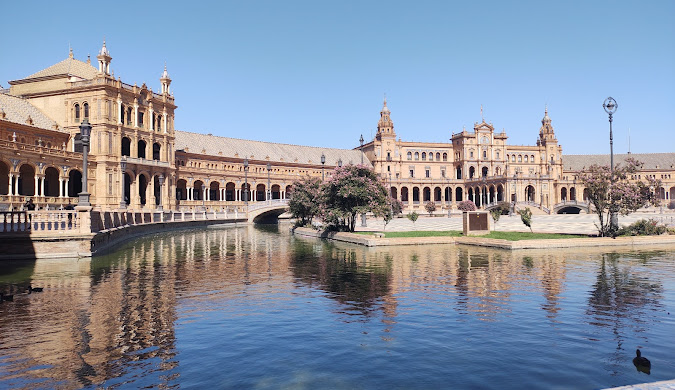
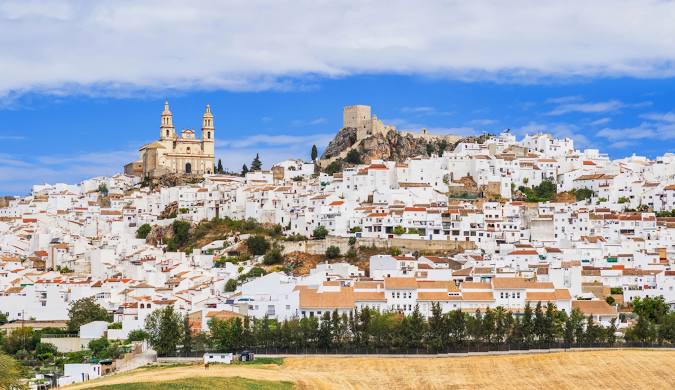
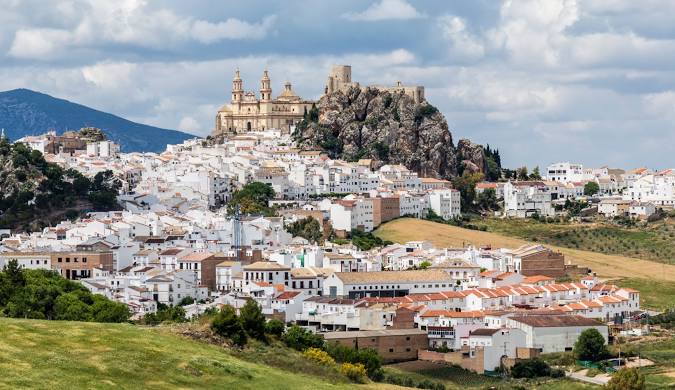
Seville – 45 minutes by train. The capital of Andalusia offers the Alcázar, Cathedral with Giralda tower, and the vibrant Triana neighborhood. Definitely worth a full day.
Granada – 2.5 hours by train. The Alhambra palace complex is Spain’s most visited monument. You’ll need a full day minimum, and book Alhambra tickets months in advance.
Málaga – 1 hour by train. Costa del Sol beaches, Picasso Museum, and excellent food scene. Great for a change of pace.
All these cities are easily accessible via Renfe trains from Córdoba’s main station. Book tickets online at the official Renfe website for the best prices.
Car rental option: If you want to explore the pueblos blancos (white villages) like Zuheros or Priego de Córdoba, rent a car. These hillside villages are stunning but difficult to reach by public transport.
19. Hidden Gems in the Province: Off the Beaten Path
For travelers who want something different, I recommend:
Medina Azahara – Just 8 km from Córdoba, these ruins of a 10th-century palace city are spectacular. It was the seat of the Caliphate and gives you a sense of just how powerful and wealthy Islamic Spain was. The visitor center and archaeological site are both worth visiting. You can take a bus from the city center or join an organized tour.
Olive oil estates – Córdoba province produces excellent olive oil. Several estates offer tours and tastings where you learn about production and sample different varieties. It’s a peaceful countryside experience.
Priego de Córdoba – This baroque town about an hour away is called the “Water City” for its fountains. The old town is gorgeous, and it’s almost completely tourist-free.
Planning Info & Tips
20. Where to Stay: Location Matters
Near the Mezquita / Jewish Quarter: Staying in the historic center puts you steps from major attractions. The atmosphere at night when crowds leave is magical. Downside? Can be noisy, restaurants are more tourist-oriented, and you’ll pay a premium.
I stayed at a small hotel on Calle Rey Heredia and loved the convenience, though street noise was noticeable.
San Basilio / Alcázar Viejo neighborhood: Just outside the old town walls, this area is quieter and more residential while still being a 5-minute walk to attractions. Better value for accommodations and more authentic restaurants.
Ciudad Jardín or other modern neighborhoods: If you want space, air conditioning, and lower prices, staying outside the center is fine—Córdoba is small and taxis/buses are cheap. You’ll miss the historic atmosphere though.
Accommodation tip: Book well in advance if visiting during May (Patio Festival) or Semana Santa (Easter week). Prices triple and availability disappears.
21. Getting Around: Your Feet Are Enough
Córdoba is incredibly walkable—one of the most pedestrian-friendly cities I’ve visited in Spain. The entire historic center is about 2 km across, and most attractions are within a 15-minute walk of each other.
I never once used public transportation within the city. Just wear comfortable walking shoes (those cobblestones and narrow streets are charming but tough on feet).
Getting to/from the train station: It’s about a 20-minute walk or a short €5-7 taxi ride to the old town. Buses also connect the station to the center.
Parking warning: If you drive into Córdoba, don’t attempt to drive in the old town. Streets are narrow, often pedestrian-only, and parking is a nightmare. Use a parking garage on the periphery.
22. Best Time to Visit & Festivals: Timing Your Trip
Best months: April, May, October, and November offer comfortable temperatures (15-25°C) and fewer crowds than summer.
May is spectacular but crowded: The Fiesta de los Patios (Patio Festival) during the first two weeks of May is incredible—private patios open to the public, bursting with flowers. The city is electric with activity. But expect huge crowds and book accommodations 3-6 months ahead.
Summer (June-August): Brutally hot. I’m talking 38-42°C (100-108°F) regularly. Most locals escape to the coast if they can. Only visit if you can handle extreme heat and plan activities for early morning or evening.
Winter (December-February): Mild but can be rainy. Temperatures around 8-15°C. Fewer tourists, lower prices, and a different, quieter energy. Good for budget travelers who don’t mind cooler weather.
Other festivals:
- Semana Santa (Easter week) – Elaborate religious processions
- Cruces de Mayo (May 3rd) – Flower crosses throughout the city
- Feria de Córdoba (late May) – Week-long fair with flamenco, food, and festivities
23. What Not to Waste Time On: Honest Advice
After three days in Córdoba, here’s what I’d skip if I returned with limited time:
Inside Torre de Calahorra – The museum is dated and cramped. The bridge views are free and better.
Too many museums – Between Casa Andalusi, Casa de Sefarad, and various other small museums, you can get museum fatigue. Pick 1-2 max based on your specific interests.
Souvenir shopping – Most shops sell identical mass-produced items. If you want authentic crafts, look for workshops where items are actually made on-site, or skip shopping entirely.
Eating in Plaza de las Tendillas – Tourist trap restaurants with mediocre food and inflated prices. Walk three blocks in any direction for better value.
24. Sample Itineraries: Flexible Plans
One Day in Córdoba:
- Morning: Mezquita (arrive at opening, 8:30 AM)
- Late morning: Wander the Jewish Quarter, visit the Synagogue
- Lunch: Tapas in a traditional bar
- Afternoon: Alcázar and gardens
- Evening: Sunset at Roman Bridge, dinner in San Basilio
Two Days in Córdoba:
- Day 1: Follow the one-day itinerary above
- Day 2 Morning: Palacio de Viana and patios
- Day 2 Afternoon: Visit Medina Azahara ruins (half-day trip)
- Day 2 Evening: Explore new neighborhoods, craft beer tasting, dinner at Mercado Victoria
Three Days in Córdoba:
- Days 1-2: As above
- Day 3: Take a cooking class in the morning, afternoon free for remaining museums or just wandering, evening tapas crawl through multiple neighborhoods
Flexibility tip: Don’t over-schedule. Córdoba rewards slowing down—long lunches, afternoon breaks, aimless wandering. The city’s magic is in the moments between planned activities.
Frequently Asked Questions
How many days are enough for Córdoba?
Based on my experience, 2 days is the sweet spot for Córdoba. This gives you enough time to visit the major attractions without rushing, explore the neighborhoods properly, and enjoy the local food scene. You can cover the highlights in a full day if you’re efficient, but you’d miss the city’s slower, contemplative atmosphere. If you have 3 days, even better—add a cooking class, day trip to Medina Azahara, or simply enjoy longer siestas and lingering dinners.
What is the best month to visit Córdoba, Spain?
May is the most spectacular month to visit Córdoba, especially during the first two weeks when the Patio Festival transforms the city into a botanical wonderland. However, it’s also the most crowded and expensive time. If you prefer fewer tourists with still-great weather, visit in April, October, or November when temperatures range from 15-25°C. Avoid July and August unless you can handle extreme heat (often exceeding 40°C). Winter months are mild but can be rainy, though you’ll find lower prices and authentic local atmosphere.
Is Córdoba a walkable city?
Absolutely yes! Córdoba is one of Spain’s most walkable cities. The historic center is compact—about 2 km across—with most attractions within a 10-15 minute walk of each other. The old town is largely pedestrianized with narrow, winding streets perfect for exploring on foot. I never once needed public transportation during my three-day stay. Just wear comfortable shoes because those beautiful cobblestone streets can be tough on feet after a full day of sightseeing. The flat terrain also makes it easier than hillier cities like Granada.
What food is Córdoba famous for?
Córdoba is famous for several distinctive dishes that reflect its Moorish heritage and Andalusian location. Salmorejo is the star—a thick, creamy cold tomato soup served with hard-boiled egg and jamón that’s richer than gazpacho. Berenjenas con miel (fried eggplant with honey) combines sweet and savory perfectly. Ajoblanco is a luxurious white gazpacho made from almonds. Rabo de toro (oxtail stew) is a hearty local specialty. For dessert, try pastel cordobés, a sweet pastry with cidra jam. The city also maintains strong culinary traditions of artisan vermouth, olive oil, and traditional tapas culture.
Is a day trip to Córdoba from Seville worth it?
While a day trip from Seville to Córdoba is popular and feasible (only 45 minutes by train), I honestly think it’s too rushed. You can see the Mezquita and walk briefly through the Jewish Quarter in a day trip, but you’ll completely miss what makes Córdoba special—the slower pace, the hidden alleyways, the lingering over salmorejo at lunch, the sunset light on the patios. If you only have one day, go for it, but I strongly recommend staying at least one night to experience the old town after day-trippers leave. The city transforms at dusk into something magical that day visitors never see.
Final Thoughts: Why Córdoba Captured My Heart
After visiting most major Spanish cities, I can say with confidence that Córdoba offers something different. It doesn’t compete with Seville’s flamboyance or Barcelona’s cosmopolitan energy. Instead, it invites you to slow down, get lost intentionally, and appreciate layers of history coexisting peacefully.
What to do in Córdoba Spain isn’t just about ticking off monuments. It’s about standing inside the Mezquita watching light filter through arches and feeling the weight of centuries. It’s about tasting perfectly balanced salmorejo and understanding why simple ingredients, done right, need nothing else. It’s about turning a random corner and discovering a hidden patio bursting with geraniums that someone tends daily just because that’s what they’ve always done.
Don’t rush through Córdoba on a day trip from somewhere “more important.” Stay long enough to eat dinner after 9 PM when locals fill the streets. Wake early to see the Mezquita in silence. Wander until you’re completely lost and find your way back using the tower as your compass.
The city taught me that sometimes the places we almost skip become the ones we remember most fondly.
Before you go, save this guide for your trip planning! Have questions about Córdoba? Drop them in the comments below—I love helping fellow travelers plan their Andalusian adventures.
Explore more Spanish destinations on XploreHeaven.com:
- Ultimate Guide to Seville
- Granada Beyond the Alhambra
- Hidden Gems of Andalusia
- Spanish Food Guide for Indian Travelers
Reference Websites & Official Resources
For the most current information, official ticket bookings, and updated opening hours, please refer to these authoritative sources:
- Mezquita-Cathedral de Córdoba – Official website for tickets, hours, and special visits: https://mezquita-catedraldecordoba.es/
- Alcázar de los Reyes Cristianos – Official website for the fortress-palace and gardens: https://alcazardelosreyescristianos.cordoba.es/
- Tourism Córdoba – Official tourism board with comprehensive information: https://www.turismodecordoba.org/
- Palacio de Viana – Official website for visiting hours and ticket information: https://palaciodeviana.com/
- Renfe (Spanish Railways) – For booking trains to Seville, Granada, and other cities: https://www.renfe.com/
- Medina Azahara – Official archaeological site information: https://www.museosdeandalucia.es/web/conjuntoarqueologicomedinaazahara
- Córdoba Patio Festival – Official information about the May festival: https://www.patiosdecordoba.com/
- Córdoba Synagogue – Ministry of Culture information: https://www.culturaydeporte.gob.es/
Always check official websites for current opening hours, ticket prices (which can change), and any special closures before your visit. Booking major attractions like the Mezquita online in advance is highly recommended, especially during peak season.
By:
Read more articles;
- Kaas Plateau Travel Guide 2026: Best Time to Visit, Bloom Season, How to Reach & FAQs
- What Is the Quirimbas Archipelago Mozambique Known For? Complete Travel & Nature Guide
- Is Angola Safe to Travel in 2025? Your Essential Guide to Health, Crime, and Landmine Safety
- What Animals Live in Bale Mountains Ethiopia? Complete Wildlife Guide
- What to Do in Damaraland — Complete Travel Guide for First-Timers

Lovely blog! I am loving it!! Will be back later to read some more. I am taking your feeds also
Hey There. I discovered your weblog using msn. That is a really well written article. I will be sure to bookmark it and come back to learn more of your useful info. Thanks for the post. I’ll definitely comeback.
Insightful as always
Nicely put together